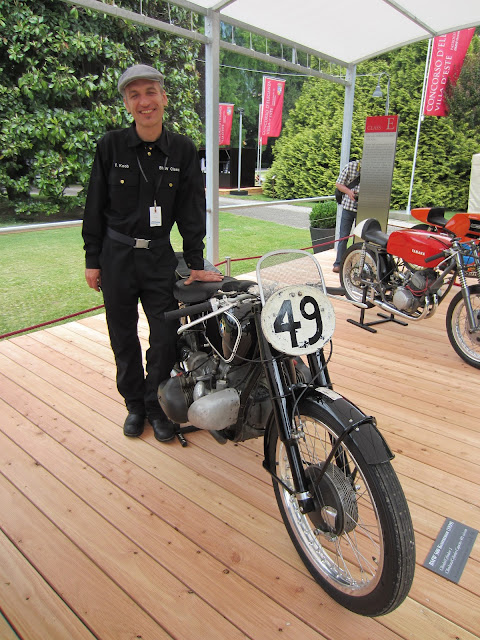As has been documented and discussed elsewhere, there was a short hiatus after the war before BMW was allowed to produce motorcycles once again. Indeed the first post-war twin didn't appear until the 1950 twin cam R51/2 was introduced. It was, in essence, a slightly modified version of the prewar bike of similar name. While a sporting bike, it wasn't a "sport bike". And a short two years later, the larger displacement R68 became the crown jewel of the BMW civilian line up, and the twin cam motor was unceremoniously dropped.
With its 26 mm carbs, magneto ignition and higher compression pistons, the R68 didn't disappoint. After its 3 year tenure, the motor platform was transitioned to the R69. In essence, the motor saw little change, but of course the frame was radically different. The rear of the bike gained a true oil dampened suspension, in place of just springs. And the Earles Fork was transitioned from the RS54 racebike, to the civilian model.
As owners of any Earles fork model know, the geometry of the front end was meant to counter act the normal dive sensation one feels when applying the front brake to a more traditionally forked bike. In fact the front end on an Earles equipped bike rises slightly. The overall geometry of the bike and front end was the reason the bike was so popular with the "seitenwagen" crowd.
Now of course when you think of 60's performance bikes, perhaps BMW isn't the first to come time mind. Nortons, Triumphs and Ducatis often lead the way in this regard, however there were plenty of "weekend warriors" looking to get extra performance from there Bavarian machines. Enter the after market suppliers.
While there were a host of offerings available to make your bike look cool, or to make it more comfortable for a long trip, there were also companies offering aftermarket performance parts with the promise of more speed.
Once such company was Bowman. They supplied cast aluminum deep sump oil pans, adding extra oil capacity and the promise of cooler oil. (A side benefit was that unlike the stock sheet metal pans, they weren't prone to warping and hence leaking when overtightened.). In addition, Bowman offered an aluminum flywheel. By decreasing the rotating mass of the motor, shifting was smoother, and less clunky. And arguably the engine revved up faster. Bowman also supplied pistons and rings.
Early on the 1950's the firm of Ernst Hoske supplied all manner of performance parts. In fact in one of their early catalogues they offered a kit, by which a handy owner could transform any pre or postwar R51 twin cam bike into an R51RS replica by swapping out the timing chain for gears, and replacing the front engine cover with a total loss version. Of course the battery coil ignition was dropped in favor of a magneto. The kit included new cams, valves and valve springs. With the addition of a tach drive, and tachometer, the average Joe could be off to the weekend races! Of course this transformation wouldn't be complete without some Hoske full width racing hubs, and a sportier tank. A full transformation would necessitate swapping out the transmission gear cluster or a more sporting version as well.
As time went on, Hoske, himself an ex-racer seemed to concentrate more efforts on after market fuel tanks, and less on true sport or racing parts. In fact his catalogue from 1965 offers six different gas tanks. Also on offer was a crank driven tachometer, an aluminum extension for the oil pan to add capacity, and an oil temperature gauge. Also offered were Renntütenform mufflers, clubman or clip on handlebars, and a sport front fender. Arguably, few of the above parts offered a true speed advantage. Still for sale, however, were sport cams, and larger valves, by which one could hope to squeak out perhaps a couple extra horsepower.
The third name that comes to mind is the firm of Schorsch Meier. With a win in the senior TT at the Isle of Mann in 1939, Meiers legacy was cast. He parlayed his fame into a successful post war motorcycle and car dealership. In fact some of his parts, such as the 6.5 gallon sport tank, and the bench seat were adopted by BMW and included as factory options when ordering a new motorcycle from Munich in the late fifties and sixties.
For further discussion of 1950's sport parts offered by Meier, see this prior
post.
It seems today, little has changed. While some guys are perfectly happy with a stock version Slash2, still others yearn to deck their bikes with performance bits and modifications, and are willing to pay for the privelege of doing so. Large Hoske tanks still command a premium, and the 6.5 gallon Meier sport tanks are almost always preferred over the smaller 4 gallon versions.



































